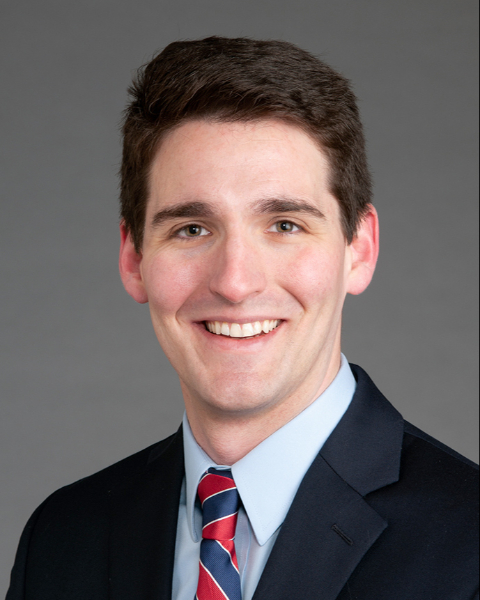SS 23 - Patient Safety 1: Using Yesterday's Data to Drive Tomorrow's Change: Advances in Patient Safety
236 - "If You're Talking, I Think You're Muted:" Follow-Up Analysis of Weekly Peer Review Discussion and Deviation Detection after Transitioning from Virtual to In-Person Format
Monday, September 30, 2024
3:50 PM - 4:00 PM ET
Location: Room 209

Ryan Hughes, MD
Wake Forest University School of Medicine
Winston Salem, NC, United States
Presenter(s)
R. T. Hughes1, J. Prasad2, N. Razavian1, J. D. Ververs1, A. C. Snavely3, C. L. Nightingale4, K. E. Weaver4, M. D. Chan5, and M. Farris5; 1Department of Radiation Oncology, Wake Forest University School of Medicine, Winston Salem, NC, 2Department of Psychology, Colorado State University College of Natural Sciences, Fort Collins, CO, 3Department of Biostatistics and Data Science, Wake Forest University School of Medicine, Winston Salem, NC, 4Department of Social Sciences and Health Policy, Wake Forest University School of Medicine, Winston Salem, NC, 5Department of Radiation Oncology, Wake Forest University School of Medicine, Winston-Salem, NC
Purpose/Objective(s): We previously identified significantly decreased rates of peer discussion and deviation detection in virtual radiotherapy (RT) peer review (PR) conferences during the COVID-19 pandemic. We performed a follow-up analysis of these outcomes (totaling 5,559 cases across both studies) and surveyed participants before and after transition back to in-person PR at the end of the COVID-19 public health emergency. Materials/
Methods: A prospectively maintained PR database was queried for consecutive cases reviewed before and after the transition from virtual to in-person conferences. Rates of PR discussion and deviation detection were summarized and compared between the virtual and in-person groups. A survey of conference participants’ perceptions and preferences on the format of our weekly PR conference was developed and conducted during virtual PR and after 3 months after the transition to in-person PR.
Results: In total, 2,110 RT plans were reviewed, 1,592 virtually and 518 after the transition back to in-person. 286 cases (13.6%) had at least one PR discussion topic recorded. The most common discussion topics included dose/fractionation (4.6%), normal tissue exposure (3.6%), and target coverage (2.2%). Peer discussion significantly increased after transition from virtual format (no discussion: 90.3%; 1 topic discussed: 8.0%; 2+ topics discussed: 1.7%) to in-person format (no discussion: 74.7%; 1 topic: 15.8%; 2+ topics: 9.5%; p<0.001). There was also a significant increase in the rate of deviation detection from virtual (1.5%) to in-person (3.3%, p=0.016) conferences. Of 35 invited participants (faculty, residents, physicists, dosimetrists, and staff), 31 completed a baseline survey during virtual PR and 28 completed the in-person follow-up survey. Compared to virtual, in-person PR was associated with a significant decrease in perceived distraction (p=0.003). There were no significant differences in perceived level of engagement in, absorption by, or concentration on the conference. During virtual PR, 43% of respondents preferred in-person compared with 52% after 3-months of in-person PR (p=0.529). At both timepoints, most respondents believed that in-person format was best for encouraging PR discussion (61-65%) and detecting/correcting errors (54-58%).
Conclusion: In this follow-up analysis of a longitudinal RT PR database, the transition from virtual to in-person PR resulted in increased rates of peer discussion and deviation detection, and decreased rates of self-reported distraction. These results suggest that an in-person component to PR is important and that efforts should be made to improve discussion and reduce distraction when performing virtual PR.
Purpose/Objective(s): We previously identified significantly decreased rates of peer discussion and deviation detection in virtual radiotherapy (RT) peer review (PR) conferences during the COVID-19 pandemic. We performed a follow-up analysis of these outcomes (totaling 5,559 cases across both studies) and surveyed participants before and after transition back to in-person PR at the end of the COVID-19 public health emergency. Materials/
Methods: A prospectively maintained PR database was queried for consecutive cases reviewed before and after the transition from virtual to in-person conferences. Rates of PR discussion and deviation detection were summarized and compared between the virtual and in-person groups. A survey of conference participants’ perceptions and preferences on the format of our weekly PR conference was developed and conducted during virtual PR and after 3 months after the transition to in-person PR.
Results: In total, 2,110 RT plans were reviewed, 1,592 virtually and 518 after the transition back to in-person. 286 cases (13.6%) had at least one PR discussion topic recorded. The most common discussion topics included dose/fractionation (4.6%), normal tissue exposure (3.6%), and target coverage (2.2%). Peer discussion significantly increased after transition from virtual format (no discussion: 90.3%; 1 topic discussed: 8.0%; 2+ topics discussed: 1.7%) to in-person format (no discussion: 74.7%; 1 topic: 15.8%; 2+ topics: 9.5%; p<0.001). There was also a significant increase in the rate of deviation detection from virtual (1.5%) to in-person (3.3%, p=0.016) conferences. Of 35 invited participants (faculty, residents, physicists, dosimetrists, and staff), 31 completed a baseline survey during virtual PR and 28 completed the in-person follow-up survey. Compared to virtual, in-person PR was associated with a significant decrease in perceived distraction (p=0.003). There were no significant differences in perceived level of engagement in, absorption by, or concentration on the conference. During virtual PR, 43% of respondents preferred in-person compared with 52% after 3-months of in-person PR (p=0.529). At both timepoints, most respondents believed that in-person format was best for encouraging PR discussion (61-65%) and detecting/correcting errors (54-58%).
Conclusion: In this follow-up analysis of a longitudinal RT PR database, the transition from virtual to in-person PR resulted in increased rates of peer discussion and deviation detection, and decreased rates of self-reported distraction. These results suggest that an in-person component to PR is important and that efforts should be made to improve discussion and reduce distraction when performing virtual PR.
